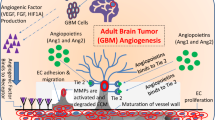Abstract
Bevacizumab (BV), a monoclonal antibody against vascular endothelial growth factor (VEGF), is currently used in the treatment of malignant glioma. To understand mechanisms of resistance to BV, we investigated morphological changes in tumor vessels and expression of angiogenic factors, such as VEGF, Flt-1, basic fibroblast growth factor (bFGF), and platelet-derived growth factor-BB (PDGF-BB), in four autopsied tumors after BV treatment. Three patients had glioblastomas; the fourth had a secondary glioblastoma that developed from a diffuse astrocytoma. BV was administered because of recurrence following the use of the Stupp regimen in these four patients. We compared the initial surgical specimen with that obtained after death following BV treatment. Immunohistochemical staining of the autopsied tumors showed that Flt-1 expression increased while VEGF expression was significantly reduced. Additionally, other angiogenic factors, particularly bFGF, were enhanced. Interestingly, the proliferation of endothelial cells was reduced, but remarkable proliferation of pericytes was observed. These results suggest that following BV treatment, glioblastomas can grow tumor vessels by expressing various angiogenic factors. These mechanisms might be important for rapid regrowth and blood brain barrier repair after BV treatment. Inhibition of multiple angiogenic factors will be required to control tumor vessels in glioblastoma.





Similar content being viewed by others
References
Ferrara N, Davis-Smyth T (1997) The biology of vascular endothelial growth factor. Endocr Rev 18:4–25
Ferrara N, Gerber HP, LeCouter J (2003) The biology of VEGF and its receptors. Nat Med 9:669–676
Presta LG, Chen H, O’Connor SJ et al (1997) Humanization of an anti-vascular endothelial growth factor monoclonal antibody for the therapy of solid tumors and other disorders. Cancer Res 57:4593–4599
Willett CG, Boucher Y, di Tomaso E et al (2004) Direct evidence that the VEGF-specific antibody bevacizumab has antivascular effects in human rectal cancer. Nat Med 10:145–147
Nagane M, Nishikawa R, Narita Y et al (2012) Phase II study of single-agent bevacizumab in Japanese patients with recurrent malignant glioma. Jpn J Clin Oncol 42:887–895
Furuta T, Nakada M, Misaki K et al (2014) Molecular analysis of a recurrent glioblastoma treated with bevacizumab. Brain Tumor Pathol 31:32–39
Bergers G, Song S (2005) The role of pericytes in blood-vessel formation and maintenance. Neuro Oncol. 7:452–464
Takeuchi H, Hashimoto N, Kitai R et al (2010) Proliferation of vascular smooth muscle cells in glioblastoma multiforme. J Neurosurg 113:218–224
Sato S, Sato Y, Hatakeyama K et al (2011) Quantitative analysis of vessels with smooth muscle layer in astrocytic tumors: correlation with histological grade and prognostic significance. Histol Histopathol 26:497–504
Lu X, Dunn J, Dickinson AM et al (2004) Smooth muscle alpha-actin expression in endothelial cells derived from CD34+ human cord blood cells. Stem Cells Dev 13:521–527
Muragaki Y, Maruyama T, Iseki H et al (2011) Phase I/IIa trial of autologous formalin-fixed tumor vaccine concomitant with fractionated radiotherapy for newly diagnosed glioblastoma. Clinical article. J Neurosurg 115:248–255
di Tomaso E, Snuderl M, Kamoun WS et al (2011) Glioblastoma recurrence after cediranib therapy in patients: lack of “rebound” revascularization as mode of escape. Cancer Res 71:19–28
Sun H, Guo D, Su Y et al (2014) Hyperplasia of pericytes is one of the main characteristics of microvascular architecture in malignant glioma. PLoS One 9:e114246
Takeuchi H, Hashimoto N, Kitai R et al (2010) Proliferation of vascular smooth muscle cells in glioblastoma multiforme. J Neurosurg 113:218–224
Louis DN, Ohgaki H, Wiestler OD et al (2007) The 2007 WHO classification of tumours of the central nervous system. Acta Neuropathol 114:97–109
Shepro D, Morel NM (1993) Pericyte physiology. FASEB J 7:1031–1038
Arimura K, Ago T, Kamouchi M et al (2012) PDGF receptor β signaling in pericytes following ischemic brain injury. Curr Neurovasc Res 9:1–9
Cheng L, Huang Z, Zhou W et al (2013) Glioblastoma stem cells generate vascular pericytes to support vessel function and tumor growth. Cell 153:139–152
Seystahl K, Tritschler I, Szabo E et al (2015) Differential regulation of TGF-β-induced, ALK-5-mediated VEGF release by SMAD2/3 versus SMAD1/5/8 signaling in glioblastoma. Neuro Oncol 17:254–265
Friedman HS, Prados MD, Wen PY et al (2009) Bevacizumab alone and in combination with irinotecan in recurrent glioblastoma. J Clin Oncol 27:4733–4740
Parliament E, Allalunis-Turner MJ, Franko AJ et al (2000) Vascular endothelial growth factor expression is independent of hypoxia in human malignant glioma spheroids and tumours. Br J Cancer 82:635–641
Stefanik DF, Fellows WK, Rizkalla LR et al (2001) Monoclonal antibodies to vascular endothelial growth factor (VEGF) and the VEGF receptor; FLT-1, inhibit the growth of C6 glioma in a mouse xenograft. J Neurooncol 55:91–100
Lu-Emerson C, Snuderl M, Kirkpatrick ND et al (2013) Increase in tumor-associated macrophages after antiangiogenic therapy is associated with poor survival among patients with recurrent glioblastoma. Neuro Oncol. 15:1079–1087
Acknowledgments
We thank Yoichiro Kato, Hideyuki Takeiri, Noriko Sakayori, and Takashi Sakayori for their help with immunohistochemistry and their scientific suggestions.
Author information
Authors and Affiliations
Corresponding author
Electronic supplementary material
Below is the link to the electronic supplementary material.
10014_2016_248_MOESM1_ESM.pdf
Hematoxylin and eosin, alpha-smooth muscle actin (αSMA), and CD31 immunohistochemical staining of the surgical and autopsied samples (scale bar, 50 µm) in Case2 and Case4. (PDF 290 kb)
10014_2016_248_MOESM2_ESM.pdf
Staining for vascular endothelial growth factor A (VEGF-A), Flt-1, basic fibroblast growth factor (bFGF), and platelet-derived growth factor-BB (PDGF-BB) Scale bar, 100 µm. Compared with the surgical samples, the expression of bFGF (I–L) were especially highly expressed in the autopsied samples (PDF 388 kb)
10014_2016_248_MOESM3_ESM.pdf
Hematoxylin and eosin, alpha-smooth muscle actin (αSMA), and CD31 immunohistochemical staining of the surgical and autopsied samples (scale bar, 50 µm) in case without BV treatment. Proliferation of pericytes around the vessels was not observed, in difference with tumor specimens obtained after Bevacizumab administration. (PDF 283 kb)
Rights and permissions
About this article
Cite this article
Okamoto, S., Nitta, M., Maruyama, T. et al. Bevacizumab changes vascular structure and modulates the expression of angiogenic factors in recurrent malignant gliomas. Brain Tumor Pathol 33, 129–136 (2016). https://doi.org/10.1007/s10014-016-0248-6
Received:
Accepted:
Published:
Issue Date:
DOI: https://doi.org/10.1007/s10014-016-0248-6




